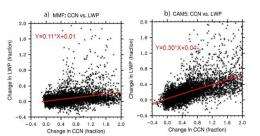Connecting the dots on aerosol details

Predicting future climate change hangs on understanding aerosols, considered the fine details in the atmosphere. Researchers at Pacific Northwest National Laboratory and the National Center for Atmospheric Research used a new modeling tool to bring the picture of aerosols and their actions on clouds into sharper focus.
The multi-scale aerosol-climate model, an extension of a multi-scale modeling framework, examined specific aerosol-cloud interactions and their effects on the Earth's energy budget, one of the toughest climate forecasting problems. Their results show that the cooling effect of human-caused atmospheric aerosols is smaller than previously thought.
Current global climate models used to predict climate change account for large-scale climate processes, typically at scales greater than 100 kilometers, or about 62 miles. This means small-scale and regional features in the climate tend to be averaged out, or estimated through parameterization, a technique used to represent complex small-scale systems. Because small-scale climate features, such as clouds and atmospheric aerosol particles, have a large impact on global climate, it's important to improve the methods used to represent those climate features in the models. This study has advanced scientists' capabilities to model and predict those complex aerosol-cloud interactions on the Earth's energy budget, for a balanced and energy-sustainable future.
Scientists at PNNL developed a new aerosol-climate model as an extension of a multi-scale modeling framework model that embeds a cloud-resolving model (CRM) within each grid column of a global climate model. This model, called the PNNL-Multi-scale Modeling Framework, depicts aerosol-cloud interactions in both stratiform and convective clouds in a more realistic way than conventional global models. In addition, the PNNL-MMF is much more computationally feasible for running multi-year climate simulations than a global CRM.

The team evaluated simulated cloud fields from the multi-scale aerosol-climate model and examined how specific human-caused aerosols, such as sulfate, black carbon (soot), and organic carbon affect those clouds and, in turn, the climate. The PNNL-MMF is a more physically based way to represent the indirect effects of aerosols compared to parameterization, typically used to represent small-scale climate details in global models. The significant computational resources available to the team at the National Center for Computational Sciences at Oak Ridge National Laboratory enabled this improvement in climate modeling.
The study compared pre-industrial and present-day results in current global models to the newer high-resolution model with the PNNL-MMF extension. Comparisons show a lesser effect on the Earth's energy budget, considering the additional burden of human-caused aerosols. These results confirm the need to use global high resolution models to study the aerosol indirect effects.
The researchers are working to understand the differences found between global models and the more detailed PNNL-MMF results. In future work, the team will tackle the aerosol effects on precipitation.
More information: Wang M, et al. "Aerosol Indirect Effects in a Multi-scale Aerosol-climate Model PNNL-MMF." 2011. Atmospheric Chemistry and Â鶹ÒùÔºics, 11, 5431-5455.
Provided by Pacific Northwest National Laboratory


















